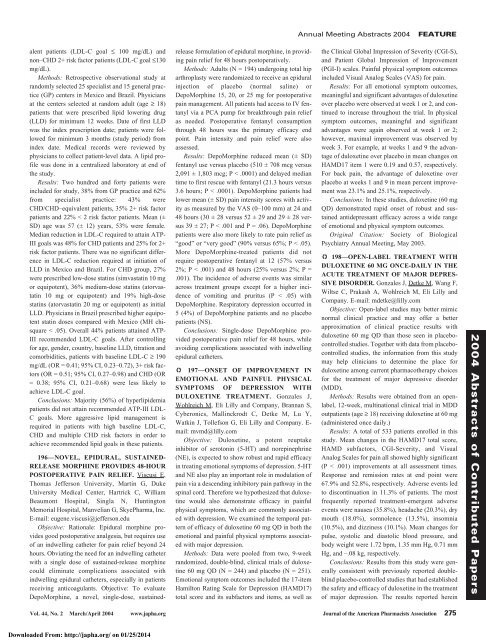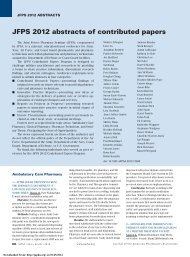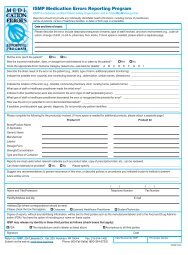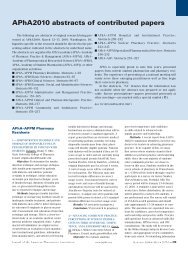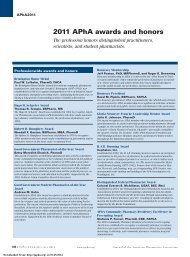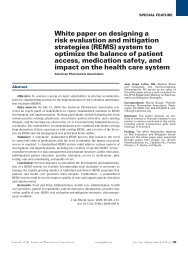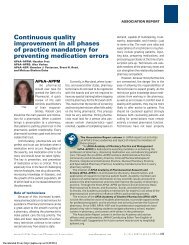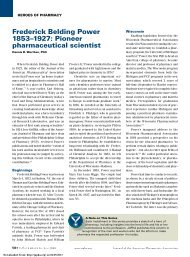Downloaded - Journal of American Pharmacists Association
Downloaded - Journal of American Pharmacists Association
Downloaded - Journal of American Pharmacists Association
You also want an ePaper? Increase the reach of your titles
YUMPU automatically turns print PDFs into web optimized ePapers that Google loves.
Annual Meeting Abstracts 2004<br />
FEATURE<br />
alent patients (LDL-C goal ≤ 100 mg/dL) and<br />
non–CHD 2+ risk factor patients (LDL-C goal ≤130<br />
mg/dL).<br />
Methods: Retrospective observational study at<br />
randomly selected 25 specialist and 15 general practice<br />
(GP) centers in Mexico and Brazil. Physicians<br />
at the centers selected at random adult (age ≥ 18)<br />
patients that were prescribed lipid lowering drug<br />
(LLD) for minimum 12 weeks. Date <strong>of</strong> first LLD<br />
was the index prescription date; patients were followed<br />
for minimum 3 months (study period) from<br />
index date. Medical records were reviewed by<br />
physicians to collect patient-level data. A lipid pr<strong>of</strong>ile<br />
was done in a centralized laboratory at end <strong>of</strong><br />
the study.<br />
Results: Two hundred and forty patients were<br />
included for study, 38% from GP practice and 62%<br />
from specialist practice: 43% were<br />
CHD/CHD–equivalent patients, 35% 2+ risk factor<br />
patients and 22% < 2 risk factor patients. Mean (±<br />
SD) age was 57 (± 12) years, 53% were female.<br />
Median reduction in LDL-C required to attain ATP-<br />
III goals was 48% for CHD patients and 25% for 2+<br />
risk factor patients. There was no significant difference<br />
in LDL-C reduction required at initiation <strong>of</strong><br />
LLD in Mexico and Brazil. For CHD group, 27%<br />
were prescribed low-dose statins (simvastatin 10 mg<br />
or equipotent), 36% medium-dose statins (atorvastatin<br />
10 mg or equipotent) and 19% high-dose<br />
statins (atorvastatin 20 mg or equipotent) as initial<br />
LLD. Physicians in Brazil prescribed higher equipotent<br />
statin doses compared with Mexico (MH chisquare<br />
< .05). Overall 44% patients attained ATP-<br />
III recommended LDL-C goals. After controlling<br />
for age, gender, country, baseline LLD, titration and<br />
comorbidities, patients with baseline LDL-C ≥ 190<br />
mg/dL (OR = 0.41; 95% CI, 0.23–0.72), 3+ risk factors<br />
(OR = 0.51; 95% CI, 0.27–0.98) and CHD (OR<br />
= 0.38; 95% CI, 0.21–0.68) were less likely to<br />
achieve LDL-C goal.<br />
Conclusions: Majority (56%) <strong>of</strong> hyperlipidemia<br />
patients did not attain recommended ATP-III LDL-<br />
C goals. More aggressive lipid management is<br />
required in patients with high baseline LDL-C,<br />
CHD and multiple CHD risk factors in order to<br />
achieve recommended lipid goals in these patients.<br />
196—NOVEL, EPIDURAL, SUSTAINED-<br />
RELEASE MORPHINE PROVIDES 48-HOUR<br />
POSTOPERATIVE PAIN RELIEF. Viscusi E,<br />
Thomas Jefferson University, Martin G, Duke<br />
University Medical Center, Hartrick C, William<br />
Beaumont Hospital, Singla N, Huntington<br />
Memorial Hospital, Manvelian G, SkyePharma, Inc.<br />
E-mail: eugene.viscusi@jefferson.edu<br />
Objective: Rationale: Epidural morphine provides<br />
good postoperative analgesia, but requires use<br />
<strong>of</strong> an indwelling catheter for pain relief beyond 24<br />
hours. Obviating the need for an indwelling catheter<br />
with a single dose <strong>of</strong> sustained-release morphine<br />
could eliminate complications associated with<br />
indwelling epidural catheters, especially in patients<br />
receiving anticoagulants. Objective: To evaluate<br />
DepoMorphine, a novel, single-dose, sustainedrelease<br />
formulation <strong>of</strong> epidural morphine, in providing<br />
pain relief for 48 hours postoperatively.<br />
Methods: Adults (N = 194) undergoing total hip<br />
arthroplasty were randomized to receive an epidural<br />
injection <strong>of</strong> placebo (normal saline) or<br />
DepoMorphine 15, 20, or 25 mg for postoperative<br />
pain management. All patients had access to IV fentanyl<br />
via a PCA pump for breakthrough pain relief<br />
as needed. Postoperative fentanyl consumption<br />
through 48 hours was the primary efficacy end<br />
point. Pain intensity and pain relief were also<br />
assessed.<br />
Results: DepoMorphine reduced mean (± SD)<br />
fentanyl use versus placebo (510 ± 708 mcg versus<br />
2,091 ± 1,803 mcg; P < .0001) and delayed median<br />
time to first rescue with fentanyl (21.3 hours versus<br />
3.6 hours; P < .0001). DepoMorphine patients had<br />
lower mean (± SD) pain intensity scores with activity<br />
as measured by the VAS (0–100 mm) at 24 and<br />
48 hours (30 ± 28 versus 52 ± 29 and 29 ± 28 versus<br />
39 ± 27; P < .001 and P = .06). DepoMorphine<br />
patients were also more likely to rate pain relief as<br />
“good” or “very good” (90% versus 65%; P < .05).<br />
More DepoMorphine-treated patients did not<br />
require postoperative fentanyl at 12 (57% versus<br />
2%; P < .001) and 48 hours (25% versus 2%; P =<br />
.001). The incidence <strong>of</strong> adverse events was similar<br />
across treatment groups except for a higher incidence<br />
<strong>of</strong> vomiting and pruritus (P < .05) with<br />
DepoMorphine. Respiratory depression occurred in<br />
5 (4%) <strong>of</strong> DepoMorphine patients and no placebo<br />
patients (NS).<br />
Conclusions: Single-dose DepoMorphine provided<br />
postoperative pain relief for 48 hours, while<br />
avoiding complications associated with indwelling<br />
epidural catheters.<br />
197—ONSET OF IMPROVEMENT IN<br />
EMOTIONAL AND PAINFUL PHYSICAL<br />
SYMPTOMS OF DEPRESSION WITH<br />
DULOXETINE TREATMENT. Gonzales J,<br />
Wohlreich M, Eli Lilly and Company, Brannan S,<br />
Cyberonics, Mallinckrodt C, Detke M, Lu Y,<br />
Watkin J, Tollefson G, Eli Lilly and Company. E-<br />
mail: mvmd@lilly.com<br />
Objective: Duloxetine, a potent reuptake<br />
inhibitor <strong>of</strong> serotonin (5-HT) and norepinephrine<br />
(NE), is expected to show robust and rapid efficacy<br />
in treating emotional symptoms <strong>of</strong> depression. 5-HT<br />
and NE also play an important role in modulation <strong>of</strong><br />
pain via a descending inhibitory pain pathway in the<br />
spinal cord. Therefore we hypothesized that duloxetine<br />
would also demonstrate efficacy in painful<br />
physical symptoms, which are commonly associated<br />
with depression. We examined the temporal pattern<br />
<strong>of</strong> efficacy <strong>of</strong> duloxetine 60 mg QD in both the<br />
emotional and painful physical symptoms associated<br />
with major depression.<br />
Methods: Data were pooled from two, 9-week<br />
randomized, double-blind, clinical trials <strong>of</strong> duloxetine<br />
60 mg QD (N = 244) and placebo (N = 251).<br />
Emotional symptom outcomes included the 17-item<br />
Hamilton Rating Scale for Depression (HAMD17)<br />
total score and its subfactors and items, as well as<br />
the Clinical Global Impression <strong>of</strong> Severity (CGI-S),<br />
and Patient Global Impression <strong>of</strong> Improvement<br />
(PGI-I) scales. Painful physical symptom outcomes<br />
included Visual Analog Scales (VAS) for pain.<br />
Results: For all emotional symptom outcomes,<br />
meaningful and significant advantages <strong>of</strong> duloxetine<br />
over placebo were observed at week 1 or 2, and continued<br />
to increase throughout the trial. In physical<br />
symptom outcomes, meaningful and significant<br />
advantages were again observed at week 1 or 2;<br />
however, maximal improvement was observed by<br />
week 3. For example, at weeks 1 and 9 the advantage<br />
<strong>of</strong> duloxetine over placebo in mean changes on<br />
HAMD17 item 1 were 0.19 and 0.57, respectively.<br />
For back pain, the advantage <strong>of</strong> duloxetine over<br />
placebo at weeks 1 and 9 in mean percent improvement<br />
was 23.1% and 25.1%, respectively.<br />
Conclusions: In these studies, duloxetine (60 mg<br />
QD) demonstrated rapid onset <strong>of</strong> robust and sustained<br />
antidepressant efficacy across a wide range<br />
<strong>of</strong> emotional and physical symptom outcomes.<br />
Original Citation: Society <strong>of</strong> Biological<br />
Psychiatry Annual Meeting, May 2003.<br />
198—OPEN-LABEL TREATMENT WITH<br />
DULOXETINE 60 MG ONCE-DAILY IN THE<br />
ACUTE TREATMENT OF MAJOR DEPRES-<br />
SIVE DISORDER. Gonzales J, Detke M, Wang F,<br />
Wiltse C, Prakash A, Wohlreich M, Eli Lilly and<br />
Company. E-mail: mdetke@lilly.com<br />
Objective: Open-label studies may better mimic<br />
normal clinical practice and may <strong>of</strong>fer a better<br />
approximation <strong>of</strong> clinical practice results with<br />
duloxetine 60 mg QD than those seen in placebocontrolled<br />
studies. Together with data from placebocontrolled<br />
studies, the information from this study<br />
may help clinicians to determine the place for<br />
duloxetine among current pharmacotherapy choices<br />
for the treatment <strong>of</strong> major depressive disorder<br />
(MDD).<br />
Methods: Results were obtained from an openlabel,<br />
12-week, multinational clinical trial in MDD<br />
outpatients (age ≥ 18) receiving duloxetine at 60 mg<br />
(administered once daily.)<br />
Results: A total <strong>of</strong> 533 patients enrolled in this<br />
study. Mean changes in the HAMD17 total score,<br />
HAMD subfactors, CGI-Severity, and Visual<br />
Analog Scales for pain all showed highly significant<br />
(P < .001) improvements at all assessment times.<br />
Response and remission rates at end point were<br />
67.9% and 52.8%, respectively. Adverse events led<br />
to discontinuation in 11.3% <strong>of</strong> patients. The most<br />
frequently reported treatment-emergent adverse<br />
events were nausea (35.8%), headache (20.3%), dry<br />
mouth (18.0%), somnolence (13.5%), insomnia<br />
(10.5%), and dizziness (10.1%). Mean changes for<br />
pulse, systolic and diastolic blood pressure, and<br />
body weight were 1.72 bpm, 1.35 mm Hg, 0.71 mm<br />
Hg, and –.08 kg, respectively.<br />
Conclusions: Results from this study were generally<br />
consistent with previously reported doubleblind<br />
placebo-controlled studies that had established<br />
the safety and efficacy <strong>of</strong> duloxetine in the treatment<br />
<strong>of</strong> major depression. The results reported herein<br />
2004 Abstracts <strong>of</strong> Contributed Papers<br />
Vol. 44, No. 2 March/April 2004 www.japha.org <strong>Journal</strong> <strong>of</strong> the <strong>American</strong> <strong>Pharmacists</strong> <strong>Association</strong> 275<br />
<strong>Downloaded</strong> From: http://japha.org/ on 01/25/2014


